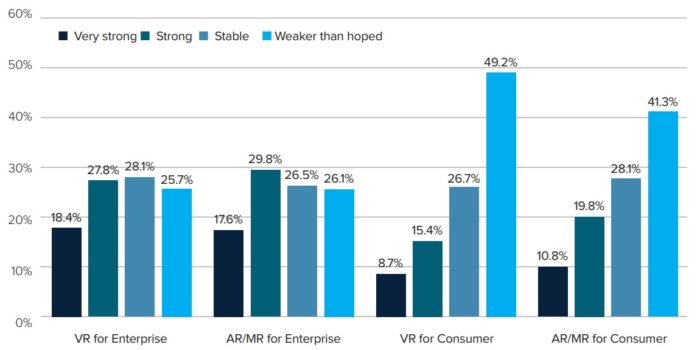For experience designers, it’s really exciting to pass the visual sense and start to have a whole sensory array to start designing with.
Jordan Higgins is Head of Immersive Experience at U.Group, an award-winning digital transformation and creative design company focused on the customer-centric experience. He is also an Instructor for Design at George Mason University.
In this episode of Velocitize Talks, Higgins shares his thoughts on virtual reality, immersive marketing and 360 video.
Virtual Reality, on demand (1:20)
Data science and engineering has been one of the fastest growing capabilities that we’ve seen. In terms of the immersive AR/VR side of things, the demand for people that are familiar with XR and the things that go along with that—3D, animation, game engines, things that were traditionally in the game development world—we’re seeing a lot of demand for more applications.
According to a recent study by VR Intelligence, enterprise VR (Virtual Reality) is growing twice as fast as consumer VR. Businesses are increasingly looking for employees who are experienced in all aspects of XR (Extended Reality), especially in the field of digital marketing and immersive technology.

AR & ROI (2:03)
Where we’re seeing the most demand in the market right now is for mobile augmented reality. They’re seeing more of it out there from big brands and influencers. The technology itself and the capability is getting to a point now where there’s broad enough adoption that…you’re seeing that return on investment.
A number of bigger retail brands have used AR to their advantage in their marketing campaigns, including Nike, adidas, Lego and more. adidas employed AR at ComplexCon in 2018 to sell its limited edition sneakers.

Most people are familiar with VR for gaming (such as the wildly popular Pokémon Go) but as a relatively new technology, business use cases are not so widely known. Walmart has used VR in its customer service training, and Volvo has used it for customer test drives. VR spans industries from education to healthcare to manufacturing. One-third of consumers report being more likely to engage with an immersive video ad.
Speed of sound (3:49)
It’s really exciting to think past the visual sense. The spatial audio becomes one of the first areas for opportunity to think about. How do we recreate real ambient sound and important cues in an environment? To tie into training in the football program—having the roar of the crowds, the play calls and calls from players who are in different positions—adds a tremendous amount to the realism.
In 2011, the NFL and NFL Players Association had worked out a new Collective Bargaining Agreement for training that would reduce the number of off-season practices and limit contact practices. In order to help mitigate any negative impact on performance, U.Group worked with the NFL to simulate a realistic competition environment for the players.
Go virtual (6:26)
We always start with…strategy. Whether it’s an immersive project or not, trying to really understand who the people are that are involved. What is the problem that you’re trying to solve? Where are the opportunities to address them? Really focusing on what that measurable impact is early on drives finding the best uses of the technology.
A great example of a brand leveraging 360 video is the movie trailer for The Conjuring 2 from Warner Bros. As soon as the video begins, you enter a virtual house with haunting music in the background. All you can do is keep frantically swiveling around, as you might do in a real-life haunted house.
It starts with a story (7:36)
NASA’s earth science observation team [was] looking for a way to communicate the value of earth science observations and what its impact is on everyday life. It’s a really good example of why starting with story makes for a compelling experience, whatever the immersive aspect of it is.
When you think of NASA, you think of space. But they also have plenty to do right here on Earth. In order to promote the mission of the NASA Earth Applied Sciences program, U.Group partnered with NASA to change the perceptions of the agency. For their important work, U.Group won gold at the 2019 MarCom awards.

Immersive websites = Immersive experience (9:20)
What I’m most excited about on the horizon…[is] WebXR…this ability to create high quality augmented and virtual reality experiences using the web. That conversation is going from “wouldn’t it be cool if” to “well, let’s build a proof-of-concept.”
The WebXR Device API is essentially an umbrella term comprising AR, VR and MR (Mixed Reality), making it an integral component of immersive technologies. In just two years, the XR market is expected to reach $209 billion.
To learn more about U.Group, visit their website and follow them on LinkedIn and Twitter at @UGroupSocial.





Join the conversation